Abstract
To assess the association between recombination and nondisjunction of chromosome 21, we analyzed cytogenetic and DNA markers in 104 trisomy 21 individuals and their parents. Our DNA marker studies of parental origin were informative in 100 cases, with the overwhelming majority (94) being maternal in origin. This value is significantly higher than the 75%–80% maternal nondisjunction rate typically observed in cytogenetic studies of trisomy 21 and illustrates the increased accuracy of the molecular approach. Using the maternally derived cases and probing at 19 polymorphic sites on chromosome 21, we created a genetic map that spans most of the long arm of chromosome 21. The map was significantly shorter than the normal female linkage map, indicating that absence of pairing and/or recombination contributes to nondisjunction in a substantial proportion of cases of trisomy 21.
Full text
PDF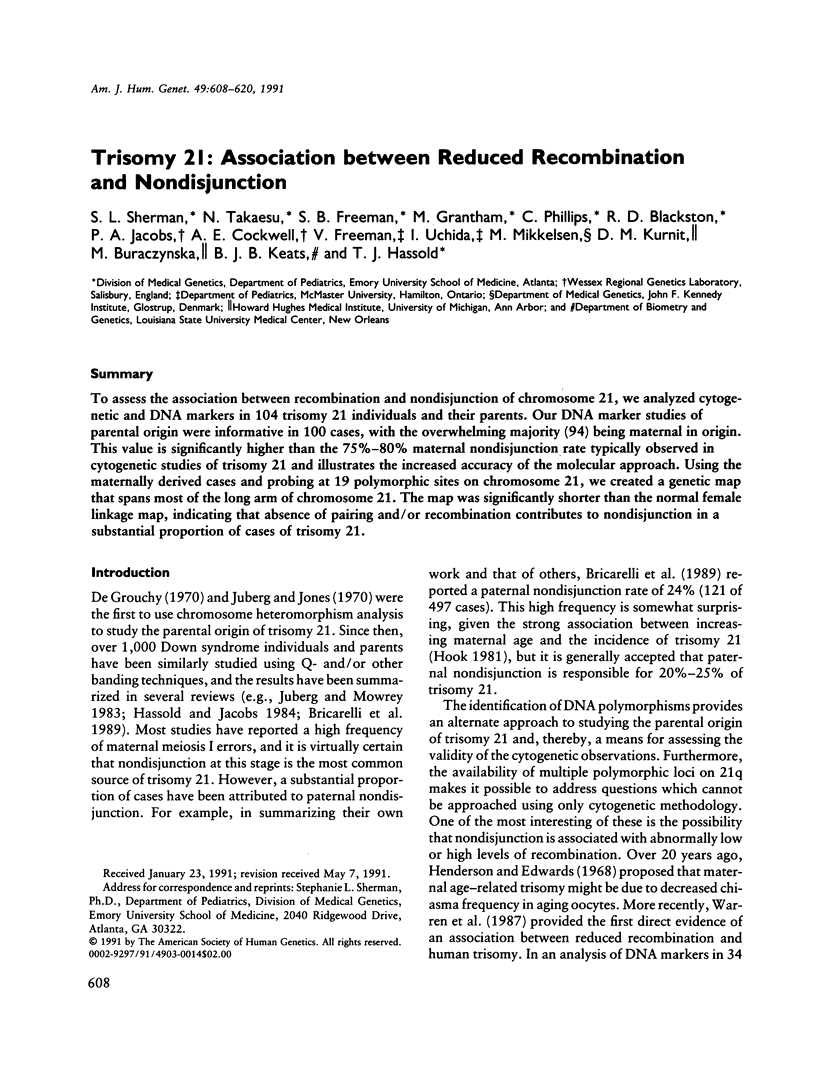
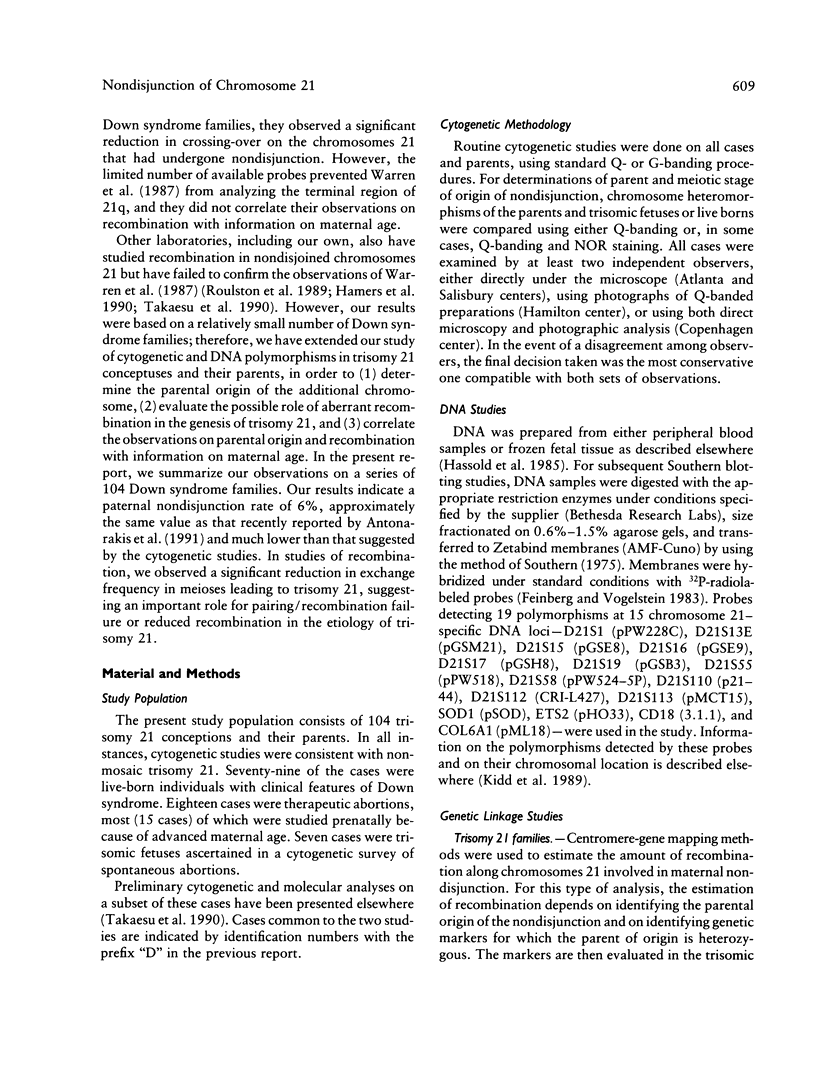
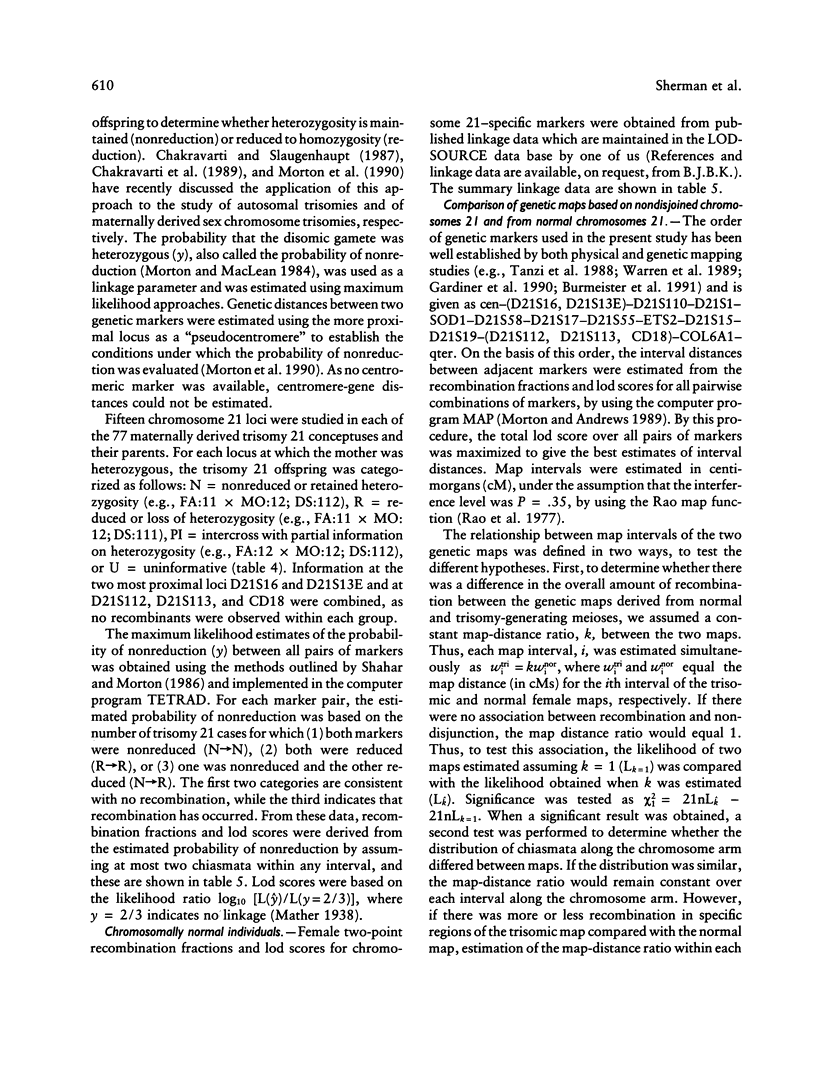

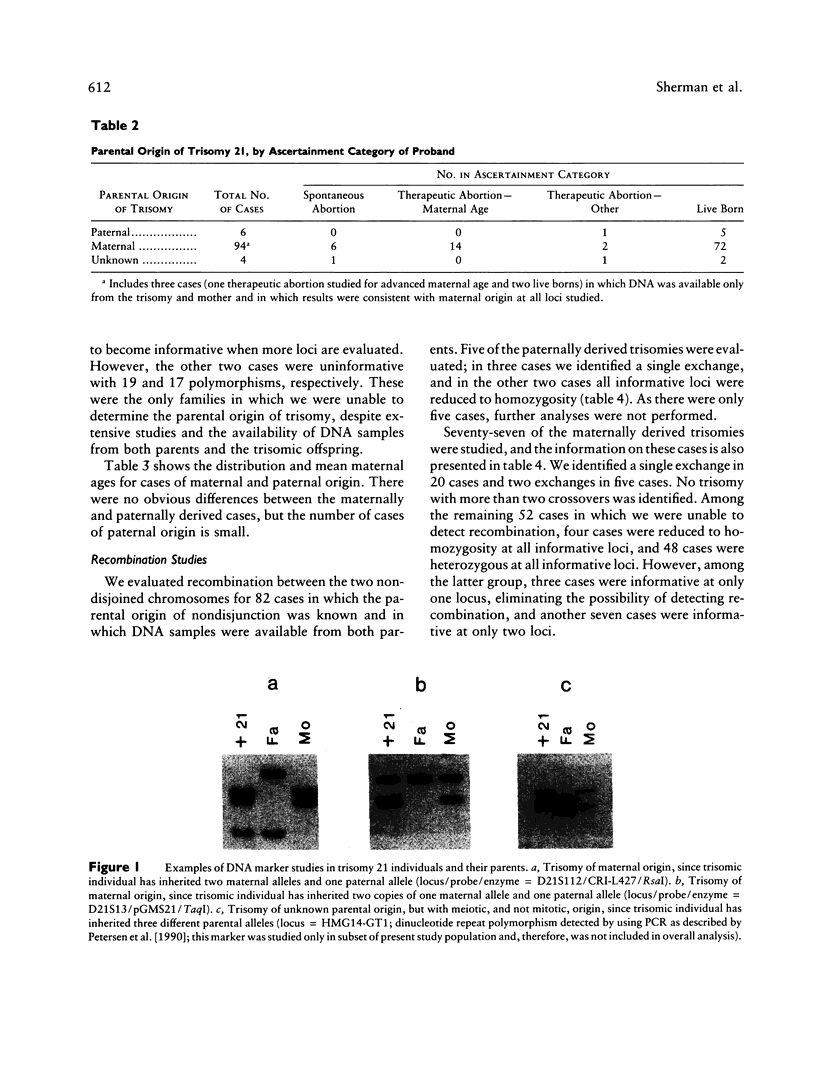

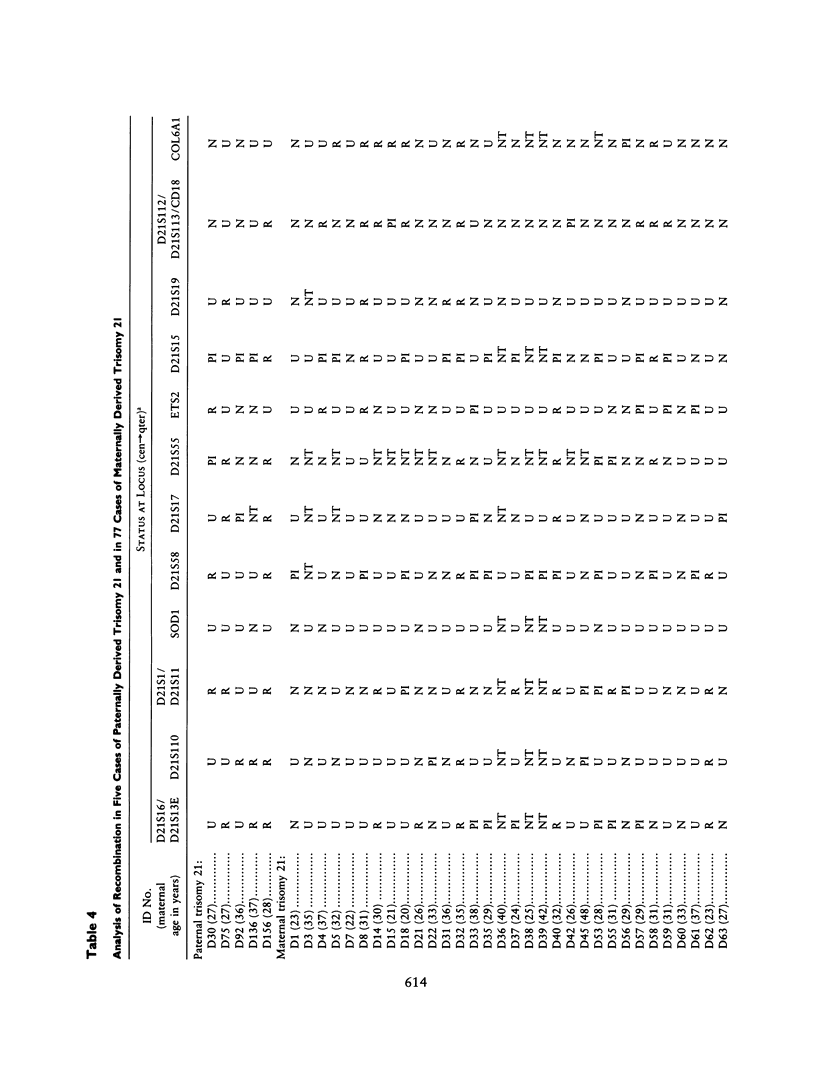


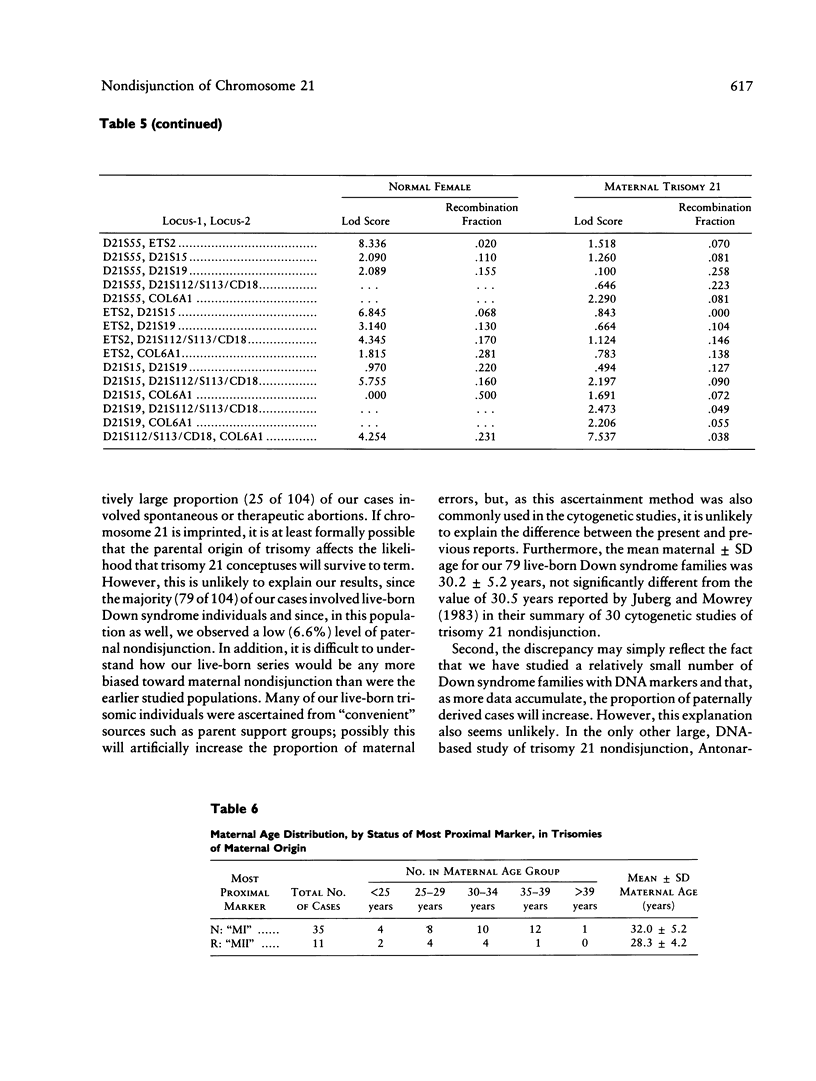
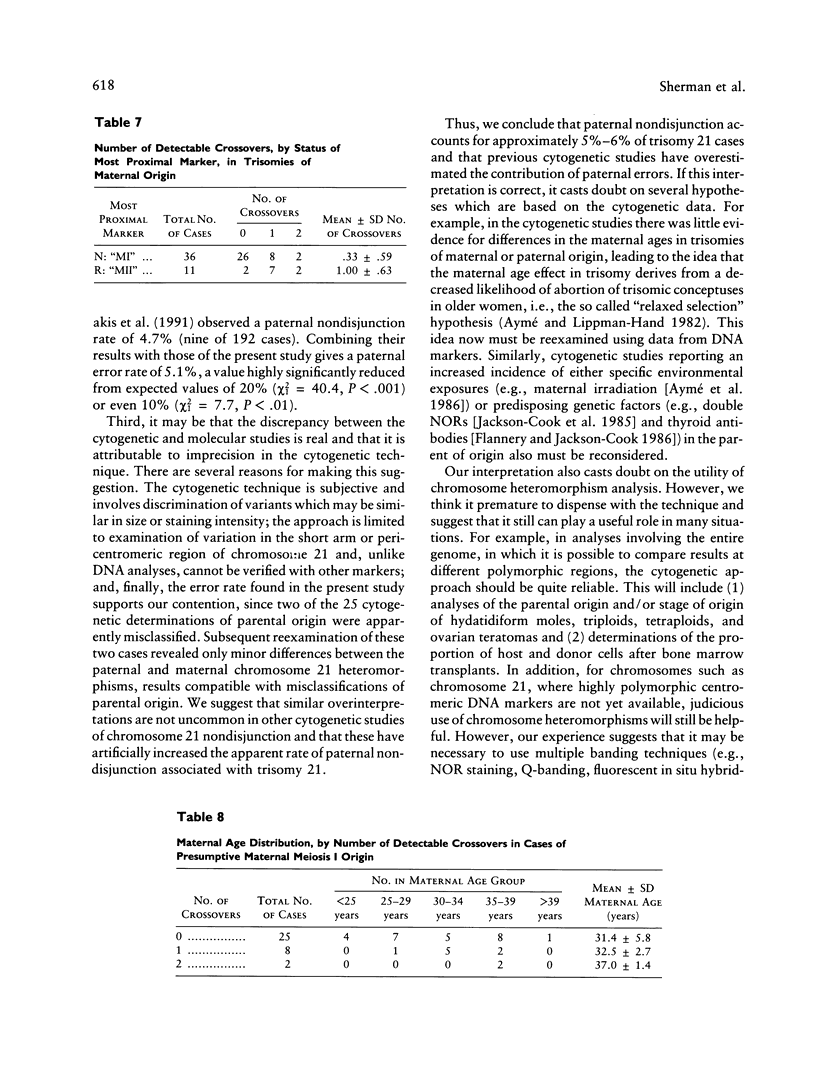


Images in this article
Selected References
These references are in PubMed. This may not be the complete list of references from this article.
- Antonarakis S. E. Parental origin of the extra chromosome in trisomy 21 as indicated by analysis of DNA polymorphisms. Down Syndrome Collaborative Group. N Engl J Med. 1991 Mar 28;324(13):872–876. doi: 10.1056/NEJM199103283241302. [DOI] [PubMed] [Google Scholar]
- Aymé S., Lippman-Hand A. Maternal-age effect in aneuploidy: does altered embryonic selection play a role? Am J Hum Genet. 1982 Jul;34(4):558–565. [PMC free article] [PubMed] [Google Scholar]
- Burmeister M., Kim S., Price E. R., de Lange T., Tantravahi U., Myers R. M., Cox D. R. A map of the distal region of the long arm of human chromosome 21 constructed by radiation hybrid mapping and pulsed-field gel electrophoresis. Genomics. 1991 Jan;9(1):19–30. doi: 10.1016/0888-7543(91)90216-2. [DOI] [PubMed] [Google Scholar]
- Chakravarti A., Majumder P. P., Slaugenhaupt S. A., Deka R., Warren A. C., Surti U., Ferrell R. E., Antonarakis S. E. Gene-centromere mapping and the study of non-disjunction in autosomal trisomies and ovarian teratomas. Prog Clin Biol Res. 1989;311:45–79. [PubMed] [Google Scholar]
- Chakravarti A., Slaugenhaupt S. A. Methods for studying recombination on chromosomes that undergo nondisjunction. Genomics. 1987 Sep;1(1):35–42. doi: 10.1016/0888-7543(87)90102-9. [DOI] [PubMed] [Google Scholar]
- Dagna Bricarelli F., Pierluigi M., Landucci M., Arslanian A., Coviello D. A., Ferro M. A., Strigini P. Parental age and the origin of trisomy 21. A study of 302 families. Hum Genet. 1989 Apr;82(1):20–26. doi: 10.1007/BF00288265. [DOI] [PubMed] [Google Scholar]
- Feinberg A. P., Vogelstein B. A technique for radiolabeling DNA restriction endonuclease fragments to high specific activity. Anal Biochem. 1983 Jul 1;132(1):6–13. doi: 10.1016/0003-2697(83)90418-9. [DOI] [PubMed] [Google Scholar]
- Gardiner K., Horisberger M., Kraus J., Tantravahi U., Korenberg J., Rao V., Reddy S., Patterson D. Analysis of human chromosome 21: correlation of physical and cytogenetic maps; gene and CpG island distributions. EMBO J. 1990 Jan;9(1):25–34. doi: 10.1002/j.1460-2075.1990.tb08076.x. [DOI] [PMC free article] [PubMed] [Google Scholar]
- Hamers A. J., Meyer H., Jongbloed R. J., van der Hulst R. R., Geraedts J. P. Rate of recombination of chromosomes 21 in parents of children with Down syndrome. Clin Genet. 1990 Jun;37(6):463–469. doi: 10.1111/j.1399-0004.1990.tb03531.x. [DOI] [PubMed] [Google Scholar]
- Hassold T. J., Jacobs P. A. Trisomy in man. Annu Rev Genet. 1984;18:69–97. doi: 10.1146/annurev.ge.18.120184.000441. [DOI] [PubMed] [Google Scholar]
- Hassold T., Kumlin E., Takaesu N., Leppert M. Determination of the parental origin of sex-chromosome monosomy using restriction fragment length polymorphisms. Am J Hum Genet. 1985 Sep;37(5):965–972. [PMC free article] [PubMed] [Google Scholar]
- Henderson S. A., Edwards R. G. Chiasma frequency and maternal age in mammals. Nature. 1968 Apr 6;218(5136):22–28. doi: 10.1038/218022a0. [DOI] [PubMed] [Google Scholar]
- Jabs E. W., Warren A. C., Taylor E. W., Colyer C. R., Meyers D. A., Antonarakis S. E. Alphoid DNA polymorphisms for chromosome 21 can be distinguished from those of chromosome 13 using probes homologous to both. Genomics. 1991 Jan;9(1):141–146. doi: 10.1016/0888-7543(91)90231-3. [DOI] [PubMed] [Google Scholar]
- Jackson-Cook C. K., Flannery D. B., Corey L. A., Nance W. E., Brown J. A. Nucleolar organizer region variants as a risk factor for Down syndrome. Am J Hum Genet. 1985 Nov;37(6):1049–1061. [PMC free article] [PubMed] [Google Scholar]
- Juberg R. C., Jones B. The Christchurch chromosome (Gp-). Mongolism, erythroleukemia and an inherited Gp- chromosome (Christchurch). N Engl J Med. 1970 Feb 5;282(6):292–297. doi: 10.1056/NEJM197002052820602. [DOI] [PubMed] [Google Scholar]
- Juberg R. C., Mowrey P. N. Origin of nondisjunction in trisomy 21 syndrome: all studies compiled, parental age analysis, and international comparisons. Am J Med Genet. 1983 Sep;16(1):111–116. doi: 10.1002/ajmg.1320160117. [DOI] [PubMed] [Google Scholar]
- Kidd K. K., Bowcock A. M., Schmidtke J., Track R. K., Ricciuti F., Hutchings G., Bale A., Pearson P., Willard H. F., Gelernter J. Report of the DNA committee and catalogs of cloned and mapped genes and DNA polymorphisms. Cytogenet Cell Genet. 1989;51(1-4):622–947. doi: 10.1159/000132810. [DOI] [PubMed] [Google Scholar]
- Morton N. E., Andrews V. MAP, an expert system for multiple pairwise linkage analysis. Ann Hum Genet. 1989 Jul;53(Pt 3):263–269. doi: 10.1111/j.1469-1809.1989.tb01793.x. [DOI] [PubMed] [Google Scholar]
- Morton N. E., Keats B. J., Jacobs P. A., Hassold T., Pettay D., Harvey J., Andrews V. A centromere map of the X chromosome from trisomies of maternal origin. Ann Hum Genet. 1990 Jan;54(Pt 1):39–47. doi: 10.1111/j.1469-1809.1990.tb00359.x. [DOI] [PubMed] [Google Scholar]
- Morton N. E., MacLean C. J. Multilocus recombination frequencies. Genet Res. 1984 Aug;44(1):99–107. doi: 10.1017/s0016672300026276. [DOI] [PubMed] [Google Scholar]
- Petersen M. B., Economou E. P., Slaugenhaupt S. A., Chakravarti A., Antonarakis S. E. Linkage analysis of the human HMG14 gene on chromosome 21 using a GT dinucleotide repeat as polymorphic marker. Genomics. 1990 May;7(1):136–138. doi: 10.1016/0888-7543(90)90531-x. [DOI] [PubMed] [Google Scholar]
- Rao D. C., Morton N. E., Lindsten J., Hultén M., Yee S. A mapping function for man. Hum Hered. 1977;27(2):99–104. doi: 10.1159/000152856. [DOI] [PubMed] [Google Scholar]
- Roulston D., Antonarakis S. E., Lewis J. G., Cohen M. M., Schwartz S. Cytological and molecular studies of nucleolar organizing region variants and recombination in trisomy 21. Prog Clin Biol Res. 1989;311:81–100. [PubMed] [Google Scholar]
- Shahar S., Morton N. E. Origin of teratomas and twins. Hum Genet. 1986 Nov;74(3):215–218. doi: 10.1007/BF00282536. [DOI] [PubMed] [Google Scholar]
- Southern E. M. Detection of specific sequences among DNA fragments separated by gel electrophoresis. J Mol Biol. 1975 Nov 5;98(3):503–517. doi: 10.1016/s0022-2836(75)80083-0. [DOI] [PubMed] [Google Scholar]
- Takaesu N., Jacobs P. A., Cockwell A., Blackston R. D., Freeman S., Nuccio J., Kurnit D. M., Uchida I., Freeman V., Hassold T. Nondisjunction of chromosome 21. Am J Med Genet Suppl. 1990;7:175–181. doi: 10.1002/ajmg.1320370735. [DOI] [PubMed] [Google Scholar]
- Tanzi R. E., Haines J. L., Watkins P. C., Stewart G. D., Wallace M. R., Hallewell R., Wong C., Wexler N. S., Conneally P. M., Gusella J. F. Genetic linkage map of human chromosome 21. Genomics. 1988 Aug;3(2):129–136. doi: 10.1016/0888-7543(88)90143-7. [DOI] [PubMed] [Google Scholar]
- Warren A. C., Chakravarti A., Wong C., Slaugenhaupt S. A., Halloran S. L., Watkins P. C., Metaxotou C., Antonarakis S. E. Evidence for reduced recombination on the nondisjoined chromosomes 21 in Down syndrome. Science. 1987 Aug 7;237(4815):652–654. doi: 10.1126/science.2955519. [DOI] [PubMed] [Google Scholar]
- Warren A. C., Slaugenhaupt S. A., Lewis J. G., Chakravarti A., Antonarakis S. E. A genetic linkage map of 17 markers on human chromosome 21. Genomics. 1989 May;4(4):579–591. doi: 10.1016/0888-7543(89)90282-6. [DOI] [PubMed] [Google Scholar]
- Waye J. S., Willard H. F. Human beta satellite DNA: genomic organization and sequence definition of a class of highly repetitive tandem DNA. Proc Natl Acad Sci U S A. 1989 Aug;86(16):6250–6254. doi: 10.1073/pnas.86.16.6250. [DOI] [PMC free article] [PubMed] [Google Scholar]
- de Grouchy J. 21 p-maternel en double exemplaire chez un trisomique 21. Ann Genet. 1970 Mar;13(1):52–55. [PubMed] [Google Scholar]



